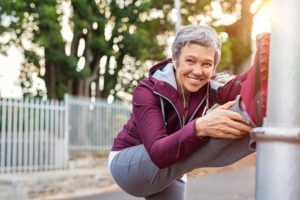
Tight muscles can often lead to the pains mentioned above and massively decrease mobility and quality of life. The truth is that when it’s easier to move, it’s a lot easier to get out and do things; you feel good, you’re upright (which breeds positivity), and getting things done with joy.
But that’s just not going to happen. To loosen up and improve mobility, you’ll need to stretch. Stiff muscles only become limber when they are stretched out, have their range increased, and are used regularly.
Jumping into stretching, however, can be dangerous. Applying added tension to a cold muscle, using poor posture, or going beyond your limits can all lead to pain and potential injury. So, when you’re about to get in that stretch, here are a few tips to remember:
Warm up: Muscles stretch more quickly when they are warm. You can perform “dynamic stretches” (stretches with movement) and kill two birds with one stone, or spend a few minutes standing marching in place, dancing, or swinging your arms before “static” stretching (holding a position).
Listen to your body: The tension created through stretching should be mildly uncomfortable, but not painful. If it hurts, stop, reposition, and try the move again. Over time your flexibility will improve.
Make a mind/muscle connection: Focus on feeling the stretch in the muscle you are targeting. That way, you’ll know you’re doing the movement properly. Also, you’ll probably notice that one side may have better mobility than the other. Focus your efforts to correct this imbalance over time.
Lastly, you’ll want to remember to breathe regularly and make stretching a regular part of your day. The more often you practice, the better you will become and the easier it will be to move around. In time, pain and immobility may be a thing of the past.